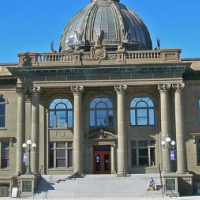FBI Bugged San Mateo County Courthouse Steps to Catch Foreclosure Bid-Riggers
 San Mateo County courthouse
San Mateo County courthouse
After the housing meltdown nearly a decade ago, the feds in Northern California investigated and prosecuted collusion among bidders for properties that had been foreclosed on in various locales. The collusion, often performed at auctions on the steps of courthouses, warped real estate values, enriched a few insiders manipulating the system and added another layer of pain for people who had just lost their homes.
Federal prosecutors started cracking down in 2011 and have obtained plea deals in at least 50 cases in Alameda, Contra Costa and San Francisco counties, but they may have a problem in a current case related to activities in 2009 and 2010.
Defense lawyers filed a motion this month in U.S. District Court to suppress more than 200 hours of warrantless recordings made outside the front of the San Mateo County courthouse in Redwood City. They also want tossed any evidence that might be related to information on the recordings.
They argued their clients had a reasonable right to believe they were having private, unbugged conversations in public space, behavior protected by the Fourth Amendment’s proscription of unreasonable searches and seizures.
It would be different if the recordings were made by an informant or federal agent wearing an authorized wire, but these came from three locations in the vicinity of the courthouse steps. That sort of electronic eavesdropping is often frowned upon by the courts.
But it may not necessarily be the Constitutional argument that carries the most weight in this case. “Imagine, as a judge, if you find out that the stairs that you walk up and down all the time are bugged,” defense lawyer Doron Weinberg told The Recorder. “We believe that Judge Breyer will take the issue seriously and we have confidence that he'll make a wise decision.”
The judge wasn’t the only person who might have been recorded. “Private affairs are routinely discussed as citizens, their lawyers, and even judges walk to and from court and lawyers often take clients aside outside the courthouse for privileged conversations,” the defense motion (pdf) noted.
The lawyers said the 31 recordings, made over a period of months, indiscriminately captured the voices of all who ventured into range. “The methodology and results of the Government’s lengthy and invasive electronic surveillance campaign suggest that the Government chose not to seek judicial authorization precisely because it knew it could not satisfy the requirements of Title III [of the Omnibus Crime Control and Safe Streets Act].”
According to the defense motion, the government claimed in its initial statements to the court the bugs―inside a metal sprinkler box attached to a wall, in a large planter box and in vehicles parked on the street―were “aimed at the public space in front of the courthouse where the public auctions took place” and broke no laws.
The lawyers wondered if it was even necessary to bug the place, considering that “FBI agents interviewed cooperators, reviewed documentary evidence, conducted surveillance at the San Mateo County courthouse (the site of some auctions), and obtained recordings of alleged illicit agreements using an informant and an undercover agent.”
And yet, “despite apparent success with these traditional investigative techniques, FBI agents planted eavesdropping devices around” the courthouse. Then again, who knows for sure how the feds conducted those investigations
–Ken Broder
To Learn More:
Feds Bugged Steps of Silicon Valley Courthouse (by Dan Goodin, Ars Technica)
Defense Claims Courthouse Was Illegally Bugged (by Ross Todd, The Recorder)
FBI and Housing Rebound Tamp Down Rampant Foreclosure Auction Bid-Rigging (by Ken Broder, AllGov California)
United States of America v. Joseph J. Giraudo, Raymond A. Grinsell, Kevin B. Cullinane, James F. Appenrodt and Abraham S. Farag (U.S. District Court Northern District of California) (pdf)
- Top Stories
- Controversies
- Where is the Money Going?
- California and the Nation
- Appointments and Resignations
- Unusual News
- Latest News
- California Forbids U.S. Immigration Agents from Pretending to be Police
- California Lawmakers Urged to Strip “Self-Dealing” Tax Board of Its Duties
- Big Oil’s Grip on California
- Santa Cruz Police See Homeland Security Betrayal in Use of Gang Roundup as Cover for Immigration Raid
- Oil Companies Face Deadline to Stop Polluting California Groundwater





